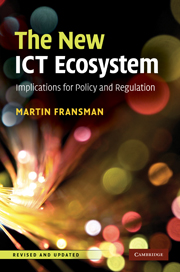Book contents
- Frontmatter
- Contents
- List of exhibits
- Preface
- List of abbreviations and acronyms
- Introduction
- 1 Summary of the argument
- 2 The new ICT ecosystem: architectural structure
- 3 The new ICT ecosystem as an innovation system
- 4 The new ICT ecosystem: a quantitative analysis
- 5 Telecoms regulation
- 6 Policy-making for the new ICT ecosystem
- 7 The way forward: the message to policy-makers and regulators
- Appendixes
- Bibliography
- Index
3 - The new ICT ecosystem as an innovation system
Published online by Cambridge University Press: 04 May 2010
- Frontmatter
- Contents
- List of exhibits
- Preface
- List of abbreviations and acronyms
- Introduction
- 1 Summary of the argument
- 2 The new ICT ecosystem: architectural structure
- 3 The new ICT ecosystem as an innovation system
- 4 The new ICT ecosystem: a quantitative analysis
- 5 Telecoms regulation
- 6 Policy-making for the new ICT ecosystem
- 7 The way forward: the message to policy-makers and regulators
- Appendixes
- Bibliography
- Index
Summary
The widespread adoption of the Internet has transformed the ICT sector, giving birth to what has been referred to as the ‘new ICT ecosystem’. But how does this ecosystem work, and what changes it over time? These questions are explored in this chapter, using some of the insights of Schumpeterian evolutionary economics.
To summarise, it can be shown that innovation – the endogenous creation of new knowledge in the ecosystem – has emerged largely from six key symbiotic relationships. These relationships are shaped by both competition and by institutions, which include financial institutions, regulation and competition law, standardisation and universities. It is these processes of innovation that make the new ICT ecosystem the restless, incessantly changing system that it is.
The evolution of the new ICT ecosystem
The essential point to grasp is that in dealing with capitalism we are dealing with an evolutionary process … Capitalism … is by nature a form or method of economic change and not only never is but never can be stationary … the fundamental impulse that sets and keeps the capitalist engine in motion comes from the new consumers' goods, the new methods of production or transportation, the new markets, the new forms of industrial organization that capitalist enterprise creates …
[It is this] process of industrial mutation – if I may use that biological term – that incessantly revolutionizes the economic structure from within, incessantly destroying the old one, incessantly creating a new one. This process of Creative Destruction is the essential fact about capitalism. […]
- Type
- Chapter
- Information
- The New ICT EcosystemImplications for Policy and Regulation, pp. 34 - 54Publisher: Cambridge University PressPrint publication year: 2010
- 1
- Cited by



